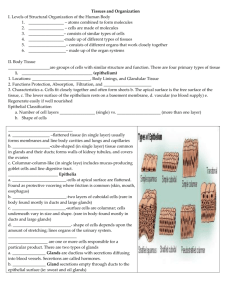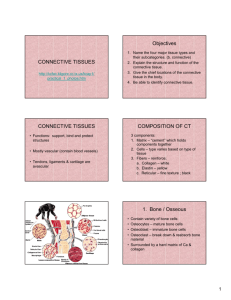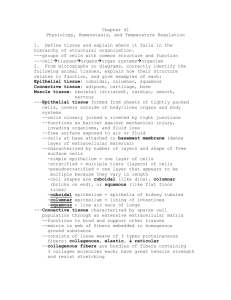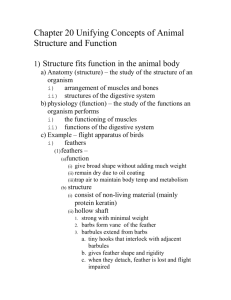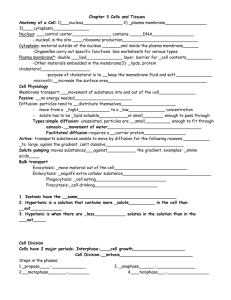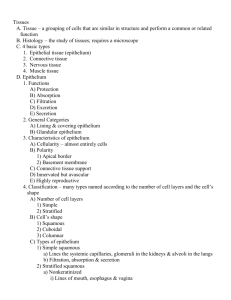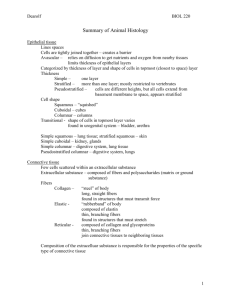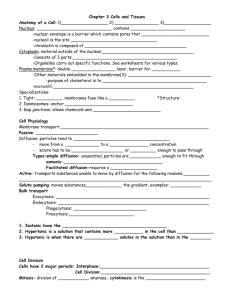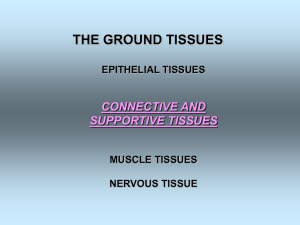Connective Tissue - Solon City Schools
advertisement
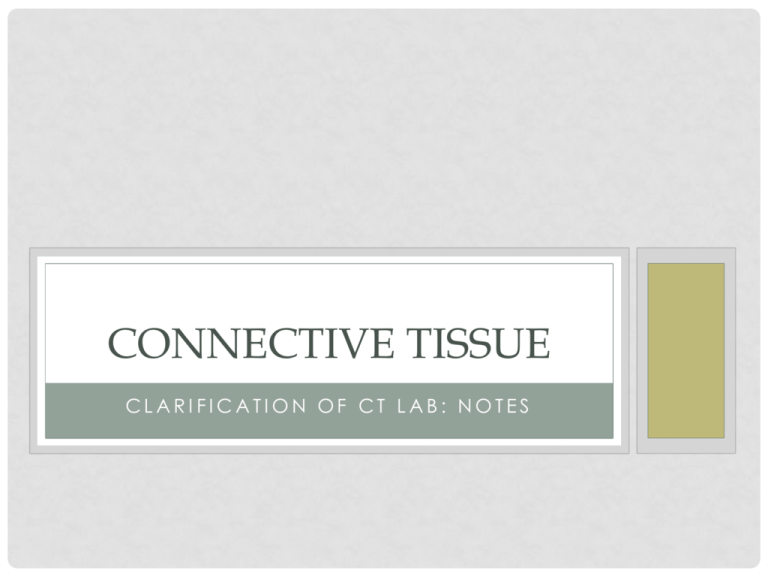
CONNECTIVE TISSUE CLARIFICATION OF CT LAB: NOTES CONNECTIVE TISSUE CLARIFICATION FUNCTIONS OF CT • Most abundant tissue • Found throughout the body. 1. Immunological Protection: Inflammation is principal function (fx) for ct and the blood vessels that pass through it. 2. 3. 4. Major Transport System Blood Connects distant body areas by circulating to all regions and carrying substances from place to place. Mechanical Support Gives body and organs the strength to resist external forces, including gravity Protecting internal organs Maintaining the proper shape of organs (to keep the trachea, or windpipe, form collapsing, for example) Providing a rigid framework on which muscle can pull, allowing movement. Nutritional Support Major site of Stored energy. Sources in adipose tissue. 2 ELEMENTS OF CONNECTIVE TISSUE 1. Cells 2. Extracellular matrix • Ground substance • Protein Fibers • The types of cells and the nature of the extracellular matrix differ among the types of CT MATRIX OR EXTRACELLULAR MATRIX • Fills the wide spaces between its cells. • Consists of protein fibers and ground substance (the material between the cells and fibers) which is a fluid, semifluid, gelatinous, or calcified. • Matrix keeps connective tissues from touching. • CT has a nerve supply • Highly vascular (rich blood supply: • Exceptions • cartilage=avascular • Tendon = scanty blood supply EXTRACELLULAR MATRIX GROUND SUBSTANCE Amorphous: no specific shape May be fluid, gel, or solid. Supports cells and binds them together. Provides a medium through which substances are exchanged between blood and cells. • Plays an active roll in tissue development, migration, proliferation, shape, and even metabolic functions. • • • • • The matrix materials determine the tissue’s qualities: • Blood: • Fluid (plasma) • Cartilage: • Firm but pliable (chondrocytes) • Bone: • Harder and not pliable (osteocytes) CELLS ASSOCIATED WITH CT • Fibroblasts: • Form fibers that are characteristic of CT • secrete collagen fibers and ground substance of the extracellular matrix • Fibrocyte: • Resting or less active fibroblasts • Macrophages: • (phago=to eat) • A type of white blood cell that ingests foreign material of both bacterial warfare and normal growth and degeneration. • key players in the immune response to foreign invaders of the body • Move through loose connective tissue by ameboid movement and engulf foreign matter as well as dead or dying cells. • Active in inflammatory conditions • Among the most independent cells in the body! 3 TYPES OF FIBERS (PRODUCED BY FIBROBLASTS) • Collagen Fibers(white): • many different types; • strong and resistant to pulling force; flexible; • occur in bundles (creating great strength) lying parallel to one another; • made of protein collagen (most abundant (25%) in body); • Found in bones, tendons, ligaments and cartilage. COLLAGEN FIBERS 2 • • • • • • • • • Most abundant Wavy bands under the microscope Formed from tropocollagen proteins that link together. Strong and resistant to stretch Give tensile strength to tissue: (the ability to withstand a pulling force without stretching much or breaking) to tissue. Compressive strength (ability to withstand compression. Location: Encases delicate organs (kidney and spleen) Location: Tendons and Ligaments Location: Form scars ELASTIC FIBERS (YELLOW) • Smaller than collagen fibers in diameter and they branch to form a network within a tissue. • Consist of a protein called elastin; surrounded by a glycoprotein called fibrillin which strengthens and stabilizes the elastic fibers. • Provide strength • Lengthen considerably when stretched, and then spring back to original length when stretching force is removed. • Springiness, or elasticity, to tissues • Found: skin, blood vessel walls, and lung tissue RETICULAR FIBERS • Thinner and less strong than collagen fibers arranged in fine bundles with a coating of glycoprotein. • Help provide a structural framework that keeps cells in place. • Support in the walls of blood vessels • Branching networks • Provide support and strength and a framework for many soft tissue organs (spleen and lymph nodes) REVIEW CONNECTIVE TISSUES • What are the 4 functions of Connective Tissues? • What are the 2 elements that make up connective tissues? • What are the 2 avascular connective tissues? • What are three cells associated with connective tissues and what do they do? • What is the difference between tensile strength and compressive strength? • What are the 3 types of fibers, what is the primary function, and where are they found?

